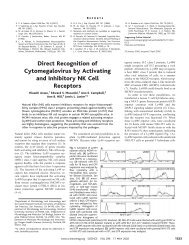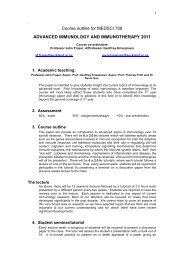Topic 2 lecture note..
Topic 2 lecture note..
Topic 2 lecture note..
Create successful ePaper yourself
Turn your PDF publications into a flip-book with our unique Google optimized e-Paper software.
so they may stick and roll along the venular endothelium. In vitro, isolated human<br />
granulocytes have been shown to roll on purified P-selectin using flow chamber systems.<br />
L-selectin and E-selectin also take part in the rolling process. When P-selectin is absent,<br />
trauma-induced rolling becomes L-selectin dependent, but the average leukocyte rolling<br />
velocity is three to five times faster in this case. This suggests that L-selectin is much less<br />
efficient than P-selectin in mediating the rolling process. However, L-selectin is<br />
necessary for the normal inflammatory response in capturing leukocytes and initiating<br />
rolling. An apparent redundancy exists between P- and E-selectin in mediating leukocyte<br />
rolling on cytokine-activated endothelium. E-selectin is thought to be responsible for<br />
slow rolling interactions, and possibly the initiation of firm adhesion.<br />
Slow rolling<br />
After induction of inflammation by injection of a pro-inflammatory cytokine like TNF-,<br />
leukocyte rolling velocity drops dramatically to an average between 5 and 10 µm/s. This<br />
rolling requires the expression of E-selectin on endothelial cells and CD18 integrins on<br />
the rolling leukocytes, and has been termed "slow rolling" to distinguish it from the much<br />
faster rolling without cytokine stimulation. Slow rolling is not based on a unique property<br />
of E-selectin, but the expression of E-selectin and/or its ligands appears to be sufficiently<br />
high in vivo to support slow rolling. The contact time during which the leukocyte is in<br />
close proximity with the endothelium, appears to be a key parameter in determining the<br />
success of the recruitment process as reflected in firm adhesion. The important role of<br />
leukocyte transit time appears to be related to chemokines that are presented on the<br />
endothelial surface and are likely to be accessible to the leukocyte as long as it rolls. This<br />
is supported by tracking studies, in which individual rolling leukocytes were found to<br />
slow down systematically before becoming firmly adherent. Rolling leukocytes are likely<br />
to be activated by surface-bound chemoattractants and through adhesion molecule-based<br />
signaling. It is also possible that the velocity of rolling may have an effect independent of<br />
transit time, because secondary binding events (e.g., 2 integrin-mediated) may not be<br />
able to form unless the leukocyte spends a certain amount of time in a position favorable<br />
for bond formation. Although slow rolling makes leukocyte recruitment much more<br />
efficient, it is not strictly required, because high concentrations of chemoattractants can<br />
also arrest fast-rolling leukocytes. Chemokines activate integrins resulting in firm<br />
adhesion of leukocytes to the vascular wall.<br />
Firm adhesion<br />
It is thought that most if not all leukocytes adhere only after having rolled. Several<br />
studies suggest that direct adhesion (from the free-flowing leukocyte pool) is extremely<br />
rare. E-selectin participates in the conversion of rolling to firm adhesion. E-selectin<br />
deficient mice have a reduced number of firmly adherent leukocytes in response to local<br />
chemoattractant or cytokine stimulation.<br />
Interfering with CD18 integrin function is one of the most efficient ways to curb<br />
leukocyte recruitment in many forms of experimental inflammation. Although the<br />
response to exogenous chemoattractant is drastically reduced when CD18 is absent or not<br />
functional, cytokine treatment still yields a robust inflammatory response in gene-





